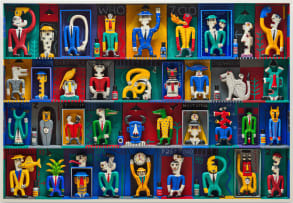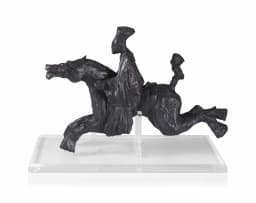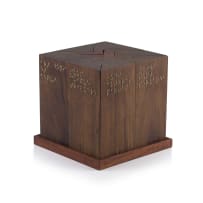isiXhosa Homestead with Family
Julius Mfethe
Incl. Buyer's Premium & VAT
About this Item
nine pieces branded with the artist's initials
Notes
There is surprisingly very little written about the work of Julius Mfete in South African art history books and on exhibition surveys despite the extraordinary skill evident in his almost miniature naturalistic contemporary sculptures. Perhaps this can be attested to the unfortunate reality of many black practicing artists in the 1980s and 1990s whose work was sold in curio shops, furniture outlets, and on craft fairs instead of through the Fine Art market where it rightfully belonged. A division that is now understood as particularly problematic in a post-apartheid context. For decades museums across the country (Wits Art Museum and Tatham Art Gallery, to name a few) have recognised Mfete as an important South African artist and acquired his work for their collections. A widely respected art historian and Professor in the Visual Arts, Anitra Nettleton, argues that Mfete should be regarded more as a key example in South African art history particularly for how he depicted the "contemporary life contexts of his community, not a romanticized vision of past primitivity."1 Born in 1957, Julius Mfete was an isiXhosa-speaker living and making art in an area of Port St. John's close to his home in Teteni location. During this time Mfete was promoted by Gail Sink through her shop in Port St. John's. He sculpted a variety of subjects, from everyday scenes to tradition, mostly using white stinkwood as a medium.2 He had a unique style, making his work easily recognisable. This present lot is a prime example. It depicts an isiXhosa homestead, ubuhlanti (kraal) and the traditional cultural roles of the family represented by the formal traditional clothing worn by each figural piece. This type of clothing would not be worn in everyday life, but rather during cultural ceremonies. The woman wears an iStufi on her head symbolising her status as wife and mother. Her husband sits to her right-hand side to symbolise his role as protector and head of the household. Their daughter, indicated by the armpieces that match her mother's, prepares the meal.
1. Anitra Nettleton (2020) Realism, Rurality and Modernity Samuel Makoanyane Julius Mfete, Zolani Mapente in African Arts, volume 53, number 2, page 72.
2. Warren Siebrits (2002) Origins of Form: Sculpture and Artefacts from Southern Africa, Johannesburg: Warren Siebrits Modern and Contemporary Art, unpaginated.
Provenance
Acquired from Mandy Meyerson in 2004.








